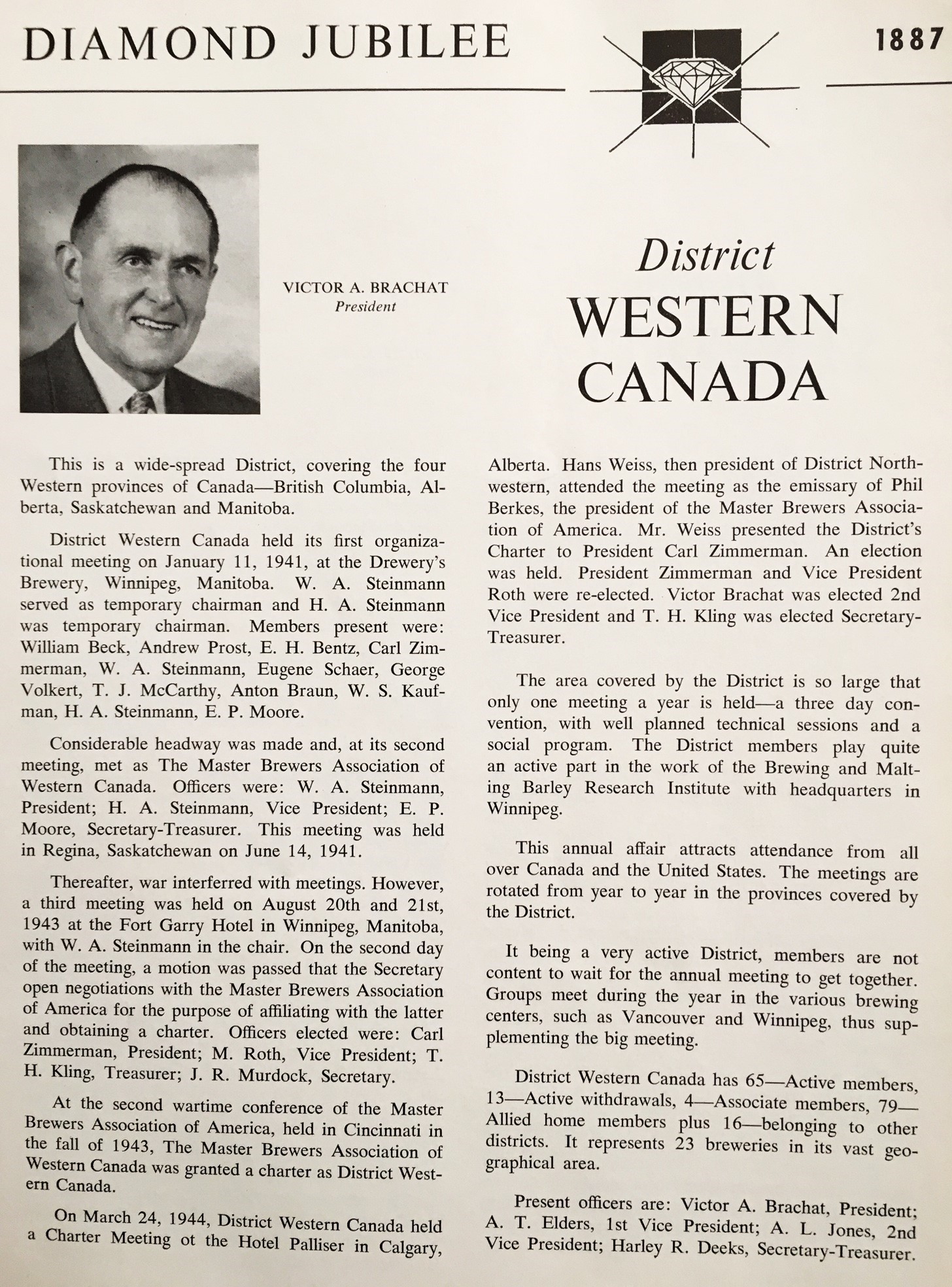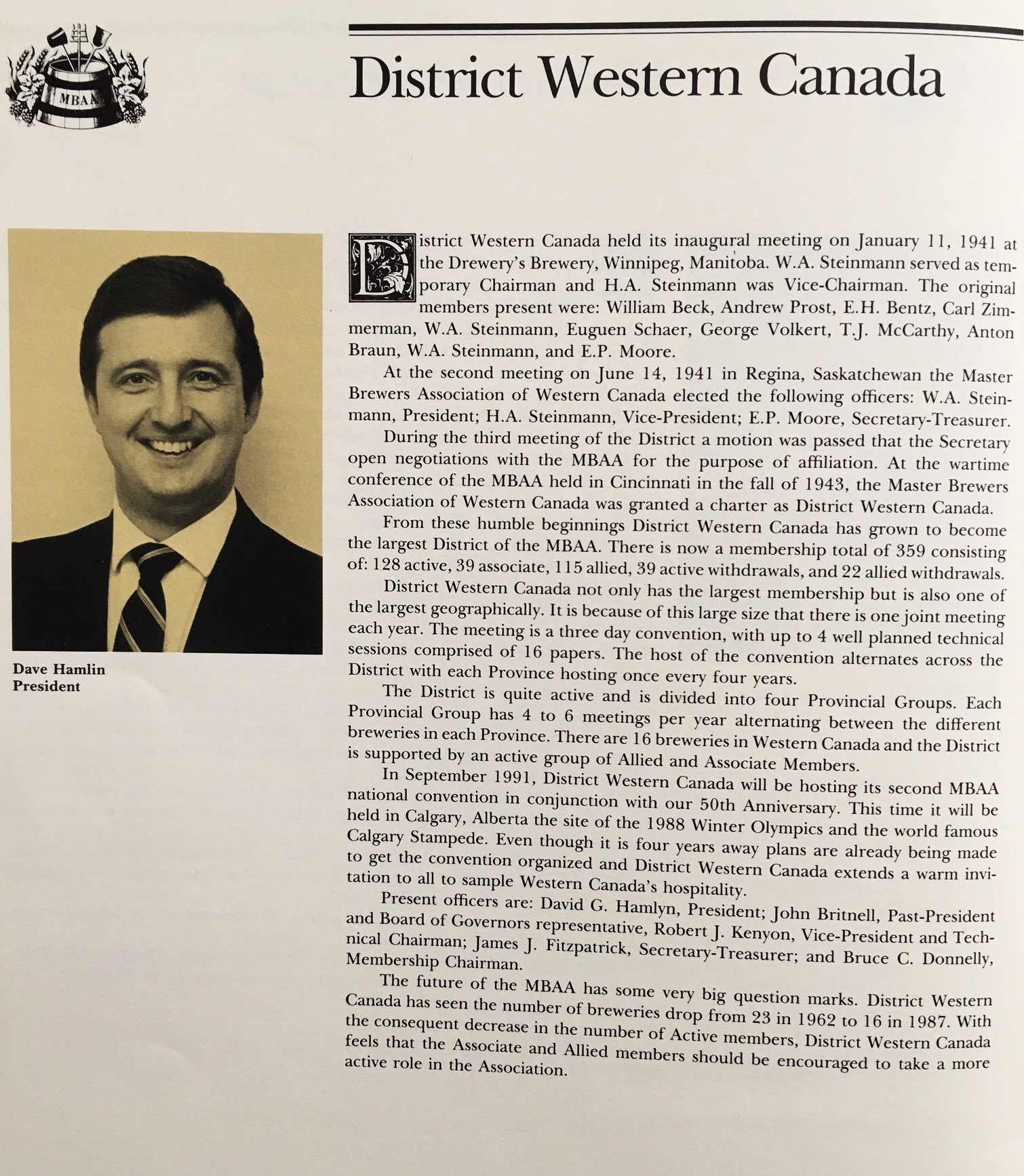From Master Brewers’ two collections of district histories, the 75th Diamond Jubilee Edition published in 1962 and the 100th Golden Jubilee Edition published in 1987, we salute District Western Canada!
Once again, I have included digital images of both histories for you to read and enjoy.
The impetus for choosing District Western Canada is quite simple. They requested some historical information to share at an upcoming meeting. It is especially exciting as they are meeting in the province of British Columbia for the first time in over 20 years!
As a reminder, in 1962 all MBAA districts were asked to submit a concise history of their district for the 75 Year Diamond Jubilee Convention. The histories would be published and distributed in a special edition of the Communicator. The history of District Western Canada was written by their president in 1962, Victor A Brachat. Victor concentrated on providing some details about when and how the District Western Canada was formed.
On January 11, 1941, a number of brewers from Canada's western provinces met together at the Drewery's Brewery in Winnipeg, Manitoba. Their purpose was to formalize their efforts to form their own master brewers association. Those efforts were successful enough that they held a second meeting the following June 14, 1941, in Regina, Saskatchewan. At that second meeting, they first met, formally, as the Master Brewers Association of Western Canada.
A third meeting was held on August 20–21, 1943 at the Fort Garry Hotel in Winnipeg. On the second day of that meeting, a motion was passed to “open negotiations” with the Master Brewers Association of America (our association's name at that time) for the purpose of officially affiliating and obtaining an MBAA district charter.
It is worth pointing out that the world was engulfed in the Second World War. After Pearl Harbor and the United States’ entry into the war, MBAA President Phil Berkes immediately called an Executive Meeting in Chicago. He and the Executive Committee put the MBAA on a “wartime footing.” For the duration of the war, MBAA conventions would be limited in scope... “wartime conferences.” The conferences limited participation to active MBAA members, and all discussion was limited to wartime production problems. Three such wartime conferences followed: Cleveland in 1942, Cincinnati in 1943, and St. Louis in 1944.
 At the second wartime conference held in Cincinnati, MBAA tabled its wartime production dialogue just long enough to grant the Master Brewers Association of Western Canada a charter as MBAA's District Western Canada. On March 24, 1944, District Western Canada held their own “charter meeting” at the Hotel Palliser in Calgary. MBAA President Berkes traveled to Calgary and officially presented the district their MBAA Charter.
At the second wartime conference held in Cincinnati, MBAA tabled its wartime production dialogue just long enough to grant the Master Brewers Association of Western Canada a charter as MBAA's District Western Canada. On March 24, 1944, District Western Canada held their own “charter meeting” at the Hotel Palliser in Calgary. MBAA President Berkes traveled to Calgary and officially presented the district their MBAA Charter.
With the war winding down in 1945, MBAA held a “Reconversion Conference” in Chicago with the intent of returning MBAA back to a normal, “peacetime footing.” The first post-war conference was scheduled for Pittsburg in 1946.
In 1987, all MBAA districts were again asked to submit a concise history of their district for the 100 year Golden Jubilee Convention. The histories would again be published and distributed. District Western Canada's 1987 District President Dave Hamlin updated the 1962 history for that document.
 Dave Hamlin also notes that in 1987:
Dave Hamlin also notes that in 1987:
-
District Western Canada was MBAA's largest district by membership with 359 members.
- It was one of the largest by geography, consisting of the four western provinces of British Columbia, Alberta, Saskatchewan, and Manitoba.
- At that time, the district hosted one “joint” (representing each of the four member provinces), convention-style meeting per year. They were typically were 3 days long and included 4 technical sessions, comprised of 16 papers. Each province hosted the joint meeting every 4 years.
- In addition, each of the four member provinces held 4–6 meetings per year, alternating among the different breweries within the province.
In that 1987 history, Dave Hamlin also recognized the impact of brewery attrition. As was so typical in the United States at that time, District Western Canada was experiencing brewery closings, consolidations, and mergers. Dave points out that the number of breweries in the four western provinces dropped from 23 in 1962 to 16 in 1987.
An historical sketch of Master Brewers also included in the 1987 Golden Jubilee document reflects upon significant events 100 years earlier in 1887. Among world events and brewery milestones, it mentions that:
"In Canada in 1887, the Canadian Pacific Railroad reached Vancouver joining the east and west coasts. In Montreal that year, the John H. R. Molson & Bros. brewery (to become Molson Breweries of Canada, Limited and now the oldest operating North American brewery) started its second century of brewing headed by the third generation of Molsons. Their records show that the average wage then in the brewing department was $1.10 a day; the most highly paid member of the brewing staff was the brewmaster who received $2.00 a day."
Your Heritage Chair congratulates the brewers in British Columbia for their efforts at rejuvenating interest in Master Brewers. I especially applaud their interest in District Western Canada's rich heritage.
